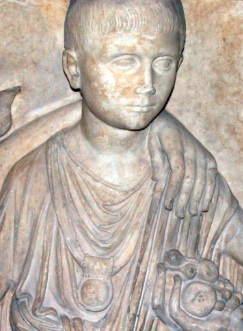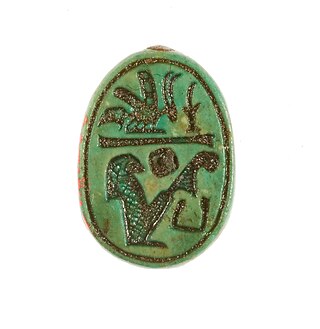
A mummy is a dead human or an animal whose soft tissues and organs have been preserved by either intentional or accidental exposure to chemicals, extreme cold, very low humidity, or lack of air, so that the recovered body does not decay further if kept in cool and dry conditions. Some authorities restrict the use of the term to bodies deliberately embalmed with chemicals, but the use of the word to cover accidentally desiccated bodies goes back to at least 1615 AD.

Egyptology is the scientific study of ancient Egypt. The topics studied include ancient Egyptian history, language, literature, religion, architecture and art from the 5th millennium BC until the end of its native religious practices in the 4th century AD. A practitioner of the discipline is an "Egyptologist".

Saqqara, also spelled Sakkara or Saccara in English, is an Egyptian village in the markaz (county) of Badrashin in the Giza Governorate, that contains ancient burial grounds of Egyptian royalty, serving as the necropolis for the ancient Egyptian capital, Memphis. Saqqara contains numerous pyramids, including the Pyramid of Djoser, sometimes referred to as the Step Tomb, and a number of mastaba tombs. Located some 30 km (19 mi) south of modern-day Cairo, Saqqara covers an area of around 7 by 1.5 km.

Mummy portraits or Fayum mummy portraits are a type of naturalistic painted portrait on wooden boards attached to upper class mummies from Roman Egypt. They belong to the tradition of panel painting, one of the most highly regarded forms of art in the Classical world. The Fayum portraits are the only large body of art from that tradition to have survived. They were formerly, and incorrectly, called Coptic portraits.
The Persian Princess or Persian Mummy is a mummy of an alleged Persian princess who surfaced in Pakistani Baluchistan in October 2000. After considerable attention and further investigation, the mummy proved to be an archaeological forgery and possibly a murder victim.

The ancient Egyptians had an elaborate set of funerary practices that they believed were necessary to ensure their immortality after death. These rituals included mummifying the body, casting magic spells, and burials with specific grave goods thought to be needed in the afterlife.

A bulla, an amulet worn like a locket, was given to male children in Ancient Rome nine days after birth. Rather similar objects are rare finds from Late Bronze Age Ireland.

The tomb of Yuya and Thuya, also known by its tomb number KV46, is the burial place of the ancient Egyptian noble Yuya and his wife Thuya, the parents of Queen Tiye the chief wife of Pharaoh Amenhotep III. Located in the Valley of the Kings, it was discovered in February 1905 by the Egyptologist James E. Quibell, excavating under the sponsorship of American millionaire Theodore M. Davis. The tomb was robbed in antiquity but preserved a great deal of its original contents including chests, beds, chairs, a chariot, and numerous storage jars. Additionally, the riffled but undamaged mummies of Yuya and Thuya were found within their disturbed coffin sets. Prior to the discovery of the tomb of Tutankhamun, this was considered to be one of the greatest discoveries in Egyptology.

Henutmehyt was the name of a Theban priestess of ancient Egypt, who lived during the 19th Dynasty, around 1250 BC. The excessive use of gold, and the high quality and detail of her coffins indicates that Henutmehyt was a wealthy woman.

The Oxyrhynchus Papyri are a group of manuscripts discovered during the late nineteenth and early twentieth centuries by papyrologists Bernard Pyne Grenfell and Arthur Surridge Hunt at an ancient rubbish dump near Oxyrhynchus in Egypt.

Menhet, Menwi and Merti, also spelled Manhata, Manuwai and Maruta, were three minor foreign-born wives of Pharaoh Thutmose III of the Eighteenth Dynasty. They are known for their lavishly furnished rock-cut tomb in Wady Gabbanat el-Qurud near Luxor, Egypt. They are suggested to be Syrian, as the names all fit into Canaanite name forms, although their ultimate origin is unknown. A West Semitic origin is likely, but both West Semitic and Hurrian derivations have been suggested for Menwi. Each of the wives bear the title of "king's wife", and were likely only minor members of the royal harem. It is not known if the women were related as the faces on the lids of their canopic jars are all different.

Scarabs are beetle-shaped amulets and impression seals which were widely popular throughout ancient Egypt. They still survive in large numbers today. Through their inscriptions and typology, they prove to be an important source of information for archaeologists and historians of the ancient world, and represent a significant body of ancient Egyptian art.

Taposiris Magna is a city established by Pharaoh Ptolemy II Philadelphus between 280 and 270 BC. The name means "great tomb of Osiris", which Plutarch identifies with an Egyptian temple in the city.
Tutankhamun's mummy was discovered by English Egyptologist Howard Carter and his team on 28 October 1925 in tomb KV62 of Egypt's Valley of the Kings. Tutankhamun was the 13th pharaoh of the 18th Dynasty of the New Kingdom of Egypt, making his mummy over 3,300 years old. Tutankhamun's mummy is the only royal mummy to have been found entirely undisturbed.

Sidi Gaber is a neighbourhood in Alexandria, Egypt.

Egyptian finger and toe stalls are pieces of gold jewelry used in Ancient Egypt to protect digits during burial. Such stalls were used during the 18th Dynasty of Egypt, as well as other eras, and were thought to protect the deceased from both magical and physical dangers, such as damage which could occur during the mummification process. Additionally, they were sometimes used in order to replace missing digits on the deceased, as it was believed that a complete body was needed for successful passage into the afterlife. This belief mirrors the myth of Osiris, whose body was put back together by his wife Isis, resulting in him becoming the first mummy. Some mummies were buried with prosthetics which they used in life, rather than toe stalls created specifically for burial. These stalls were most commonly found on the remains of royalty. Toe stalls were discovered in the tomb of Tutankhamun, and a nearly complete set of finger and toe stalls was discovered in the tomb of three of the wives of Thutmose III in Thebes. The wives' jewelry is currently on display at the Metropolitan Museum of Art. The stalls from this tomb are some of the earliest known, originating from the early 18th Dynasty. A later surviving example of toe stalls comes from the tomb of Psusennes I, a 21st Dynasty ruler. Although many surviving examples of finger and toe stalls originate from the 18th Dynasty, they were used for much of Ancient Egypt, including into the Ptolemaic and Roman periods. For example, one mummy from this period was found with carved golden finger stalls, similar to those discovered from earlier periods. Though royalty and the upper classes typically had stalls made of gold or silver, less wealthy Egyptians utilized other materials, including wood, stone, and/or mud. In order to provide magical protection for the deceased, a prayer was made to Osiris as the stalls were created. The stalls were often highly detailed, with carved nails and other features, such as rings.

The coffin of Nedjemankh is a gilded ancient Egyptian coffin from the late Ptolemaic Period. It once encased the mummy of Nedjemankh, a priest of the ram-god Heryshaf. The coffin was purchased by the New York City Metropolitan Museum of Art in July of 2017 to be the centerpiece of an exhibition entitled "Nedjemankh and His Gilded Coffin." The Metropolitan Museum of Art repatriated Nedjemankh and his coffin to Egypt in 2019, before the scheduled closure of the exhibition.
Kathleen Teresa Martínez Berry is a Dominican lawyer, archaeologist, and diplomat, best known for her work since 2005 in the search for the tomb of Cleopatra in the Taposiris Magna temple in Egypt. She heads the Egyptian-Dominican mission in Alexandria, and is currently minister counselor in charge of cultural affairs at the Dominican embassy in Egypt.
The archaeology of Ancient Egypt is the study of the archaeology of Egypt, stretching from prehistory through three millennia of documented history. Egyptian archaeology is one of the branches of Egyptology.















